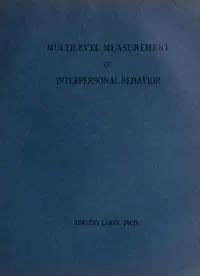
Multilevel Measurement of Interpersonal Behavior: A Manual for the Use of the Interpersonal System of Personality PDF
Preview Multilevel Measurement of Interpersonal Behavior: A Manual for the Use of the Interpersonal System of Personality
SSf '''::?--,>> MULTILEVEL MEASUREMENT OF INTERPERSONAL BEHAVIOR TIMOTHY LEARY. PH.D. ; ^J Multilevel Measurement of Behavior Interpersonal Multilevel Measurement of Behavior Interpersonal A MANUAL FOR THE USE OF THE INTERPERSONAL SYSTEM OF PERSONALITY by TIMOTHY LEARY, Ph.D. Director: Kaiser Foundation Psychology Research With the collaboration of Helen Lane, Research Administrator Anne Apfelbaum, Projects Manager Mary della Cioppa, Projects Manager Charlotte Kaufmann, Manager of Publication Psychological Consultation Service Berkeley, California, 19^6 FIRST EDITION Copyright 1956 by TIMOTHY LEARY Printed in the United States of America Clinical versus Research Use of the Interpersonal System There are two major applications of the interpersonal system in clinical diagnosis (either individual, group, or familial) and in research. The use of the system differs dramatically depending on whether the goals are clinical or research. For clinical purposes the eight-digit diagnostic code is of minor importance. The diagnostic formulation should be made from a study of the unilevel profiles supported by inspection of the test protocols. The qualitative aspects of the individual are preserved and combined with the systematic measurements. No eight-digit code can summarize the richness of an individual. The summary points may fall very close to the octant divi- sions so that a patient diagnosed as masochistic may be bordering on schizoid distrust or bordering on docile dependency. The single diagnostic digit does not reflect these shadings. Other summary points are misleading because they are resolutions of con- flicting tendencies. The resultant falls near the center of the grid. The unilevel circles pick up these ambivalences. Do not formulate the clinical picture from the diagnostic code alone. For research purposes the codes become extremely useful. When samples rather than individuals are being studied the over-simplifications due to measurement artifacts tend to balance out. What is a slightly perceptible tendency in one case (e.g., discrep- ancy between two moderate scores) becomes a significant difference if many cases pile up in the same direction. Clinical diagnosis demands the greatest detailed respect paid to the individual case. Research usually looks for trends and the summary codes are a great advantage. Timothy Leary Table Contents of Page Introduction v Part I The Interpersonal System of Personality _ 1 1. The Interpersonal System of Personality 1 Part II Multilevel Clinical Diagnosis of the Individual 7 2. Interpersonal Diagnosis of Level I Behavior 8 3. Interpersonal Diagnosis of Level II and Level V Behavior 11 4. Interpersonal Diagnosis of Level III Behavior 17 5. Multilevel Interpersonal Diagnosis : the Diagnostic Booklet 22 6. Diagnostic Report for Illustrative Patient 31 Part III Interpersonal Diagnosis of the Group and the Individual in the Group Situation 35 7. Analysis of Overt Interaction : the Sociometric Booklet 35 8. Measurement of Covert Interpersonal Attitudes in the Group 43 9. A Healthy Management Group 46 10." Analysis of Interpersonal Dynamics in a Psychotherapy 51 Group Part IV Interpersonal Analysis of Family Dynamics 56 11. Family Diagnosis 56 12. Illustrative Report for Family Diagnosis 65 Part V Research Applications of the Interpersonal System 68 13. Organization of Research Projects Employing the Inter- personal System 68 14. Multilevel Research in Personality Structure 71 15. Research on Change in Personality 79 16. Research in Group Dynamics and Family Diagnosis 83 17. Postscript to Future Users of the Interpersonal System 85 APPENDICES Appendix A. Level I-MMPI Standard Score Conversion Table 86 B. MMPI Graphic Representation: Male Norms, Female Norms.... 87 C. Level II Interpersonal Check List Standard Score Conversion Table 90 D. Level V Ideal Standard Score Conversion Table 92 E. Level III TAT Hero Standard Score Conversion Table 93 F. Level III TAT "Other" Standard Score Conversion Table 94 G. Table of Weighted Scores Indicating the Kind and the Amount of Interlevel Difference 95 H. Summary of Interpersonal Diagnoses at Levels I, II and III for Several Kaiser Foundation Samples 98 I. Summary of Interpersonal Scores and Group Dynamics Indices for Several Kaiser Foundation Samples 102 J. TAT Cookbook 104 K. The Level III Diagnosis of Underlying Character Structure Based on the MMPI 106 L. The Interpersonal Fantasy Test 110 VU
